The Assessment of the Bioeconomy and Biomass Sectors in Central and Eastern European Countries
Abstract
1. Introduction
2. Materials and Methods
3. Results and Discussions
3.1. Bioeconomy Evolution in Selected CEE Countries (2008–2019 Period)
3.2. Biomass Production and Usage in Ten CEE Countries
4. Conclusions
Author Contributions
Funding
Institutional Review Board Statement
Informed Consent Statement
Data Availability Statement
Conflicts of Interest
References
- Erb, K.H.; Haberl, H.; Defries, R.; Ellis, E.C.; Krausmann, F.; Verburg, P.H. Pushing the planetary boundaries. Science 2012, 338, 1419–1420. [Google Scholar] [CrossRef][Green Version]
- Mottet, A.; De Haan, C.; Falcucci, A.; Tempio, G.; Opio, C.; Gerber, P. Livestock: On our plates or eating at our table? A new analysis of the feed/food debate. Glob. Food Secur. 2017, 14, 1–8. [Google Scholar] [CrossRef]
- Muscat, A.; De Olde, E.; Boer, I.J.M.; Ripoll-Bosch, R. The battle for biomass: A systematic review of food-feed-fuel competition. Glob. Food Secur. 2019, 25, 100330. [Google Scholar] [CrossRef]
- European Commission. A Blueprint to Safeguard Europe’s Water Resources. Communication from the Commission to the European Parliament, The Council, The European Economic and Social Committee and The Committee of the Regions. 2012. Available online: https://eur-lex.europa.eu/legal-content/EN/ALL/?uri=CELEX:52012DC0673 (accessed on 20 October 2020).
- Moore, K.J.; Kling, C.L.; Raman, D.R. A Midwest USA Perspective on Von Cossel et al.’s Prospects of Bioenergy Cropping Systems for a More Social-Ecologically Sound Bioeconomy. Agronomy 2020, 10, 1658. [Google Scholar] [CrossRef]
- Asada, R.; Stern, T. Competitive bioeconomy? Comparing bio-based and non-bio-based primary sectors of the world. Ecol. Econ. 2018, 149, 120–128. [Google Scholar] [CrossRef]
- Antar, M.; Lyu, D.; Nazari, M.; Shah, A.; Zhou, X.; Smith, D.L. Biomass for a sustainable bioeconomy: An overview of world biomass production and utilization. Renew. Sustain. Energy Rev. 2021, 139, 110691. [Google Scholar] [CrossRef]
- Issa, I.; Delbrück, S.; Hamm, U. Bioeconomy from experts’ perspectives–Results of a global expert survey. PLoS ONE 2019, 14, e0215917. [Google Scholar] [CrossRef] [PubMed]
- Lima, M.G.B. Just transition towards a bioeconomy: Four dimensions in Brazil, India and Indonesia. For. Policy Econ. 2022, 136, 102684. [Google Scholar] [CrossRef]
- Venkatramanan, V.; Shah, S.; Rai, A.K.; Prasad, R. Nexus between crop residue burning, bioeconomy and sustainable development goals over north-western India. Front. Energy Res. 2021, 8, 392. [Google Scholar] [CrossRef]
- Govindarajan, V. Can India establish a circular bioeconomy by 2050? Sci. Report. 2021, 58, 31–33. [Google Scholar]
- Li, Q.; Zhao, Q.; Hu, Y.; Wang, H. Biotechnology and bioeconomy in China. Biotechnol. J. Healthc. Nutr. Technol. 2006, 1, 1205–1214. [Google Scholar] [CrossRef] [PubMed]
- Duan, Y.; Chen, H.; Liu, T.; Awasthi, S.K.; Pandey, A.; Zhang, Z.; Awasthi, M.K. Chapter 15-Food waste biorefinery: Case study in China for enhancing the emerging bioeconomy. In Waste Biorefinery; Bhaskar, T., Varjani, S., Pandey, A., Rene, E.R., Eds.; Elsevier: Amsterdam, The Netherlands, 2021; Volume Value Addition through Resources Utilization; pp. 421–438. ISBN 978-0-12-821879-2. [Google Scholar] [CrossRef]
- Ren, X.; Liu, T.; Awasthi, M.K.; Varjani, S.; Pandey, A.; Zhang, Z. Chapter 16-Municipal solid waste biorefineries: A case study in China. In Waste Biorefinery; Bhaskar, T., Varjani, S., Pandey, A., Rene, E.R., Eds.; Elsevier: Amsterdam, The Netherlands, 2021; Volume Value Addition through Resources Utilization; pp. 439–457. ISBN 978-0-12-821879-2. [Google Scholar] [CrossRef]
- Brandão, A.S.; Gonçalves, A.; Santos, J.M. Circular bioeconomy strategies: From scientific research to commercially viable products. J. Clean. Prod. 2021, 295, 126407. [Google Scholar] [CrossRef]
- Valli, M.; Russo, H.M.; Bolzani, V.S. The potential contribution of the natural products from Brazilian biodiversity to bioeconomy. An. Acad. Bras. Cienc. 2018, 90, 763–778. [Google Scholar] [CrossRef]
- Valverde, J.C.; Arias, D.; Campos, R.; Jiménez, M.F.; Brenes, L. Forest and agro-industrial residues and bioeconomy: Perception of use in the energy market in Costa Rica. Energy Ecol. Environ. 2021, 6, 232–243. [Google Scholar] [CrossRef]
- Trigo, E.J.; Henry, G.; Sanders, J.P.M.; Schurr, U.; Ingelbrecht, I.; Revell, C.; Santana, C.; Rocha, P. Towards Bioeconomy Development in Latin America and the Caribbean; Bioeconomy Working Paper No. 2013-01; Pontificia Universidad Javeriana: Bogotá, Colombia, 2015; pp. 15–41. Available online: https://edepot.wur.nl/356641 (accessed on 14 January 2022).
- Arisoy, H.; Avci, Y. The Evaluation of Turkey’s Bioeconomic Policies from the Agricultural Point of View. J. Inst. Sci. Technol. 2020, 10, 4. [Google Scholar] [CrossRef]
- Lalonde, C.; Wellisch, M. Sustainability Governance of Canada’s Agriculture-Based Bioeconomy. IEA Bioenergy Task 43 (Biomass Supply). 2020. Available online: https://www.ieabioenergy.com/wp-content/uploads/2020/10/Sustainability-Governance-of-Canada-Agriculture-based-Bioeconomy-full-copy-Final-Oct-26-2020.pdf (accessed on 22 January 2021).
- Kretschmer, B.; Watkins, E.; Allen, B.; Smith, C.; Buckwell, A. Technology Options for Feeding 10 Billion People: Recycling Agricultural, Forestry & Food Wastes and Residues for Sustainable Bioenergy and Biomaterials: Summary. European Parliament, Directorate-General for Internal Policies of the Union. 2014. Available online: https://ieep.eu/uploads/articles/attachments/0b10d003-ed1b-449c-b862-75ae94ebda26/Recycling_agricultural_forestry_food_wastes_and_residues_for_sustainable_bioenergy_and_biomaterials_-_summary.pdf?v=63664509830 (accessed on 12 October 2020).
- Ronzon, T.; Piotrowski, S.; Carus, M. DataM, Biomass Estimates (v3): A New Database to Quantify Biomass Availability in the European Union. Joint Research Centre, Institute for Prospective Technological Studies. 2015. Available online: https://op.europa.eu/en/publication-detail/-/publication/ce366cbc-737e-4b7a-ac9b-a10490510c0a/language-en (accessed on 22 January 2021).
- Duque-Acevedo, M.; Belmonte-Ureña, L.J.; Plaza-Úbeda, J.A.; Camacho-Ferre, F. The Management of Agricultural Waste Biomass in the Framework of Circular Economy and Bioeconomy: An Opportunity for Greenhouse Agriculture in Southeast Spain. Agronomy 2020, 10, 489. [Google Scholar] [CrossRef]
- Flak, J. Technologies for Sustainable Biomass Supply—Overview of Market Offering. Agronomy 2020, 10, 798. [Google Scholar] [CrossRef]
- Greco, C.; Comparetti, A.; Febo, P.; La Placa, G.; Mammano, M.M.; Orlando, S. Sustainable Valorisation of Biowaste for Soilless Cultivation of Salvia Officinalis in a Circular Bioeconomy. Agronomy 2020, 10, 1158. [Google Scholar] [CrossRef]
- Balafoutis, A.T.; Evert, F.K.V.; Fountas, S. Smart Farming Technology Trends: Economic and Environmental Effects, Labor Impact, and Adoption Readiness. Agronomy 2020, 10, 743. [Google Scholar] [CrossRef]
- De Carlo, A.; Tarraf, W.; Lambardi, M.; Benelli, C. Temporary Immersion System for Production of Biomass and Bioactive Compounds from Medicinal Plants. Agronomy 2021, 11, 2414. [Google Scholar] [CrossRef]
- Moll, L.; Höller, M.; Hubert, C.; Korte, C.A.C.; Völkering, G.; Wever, C.; Pude, R. Cup Plant (Silphium perfoliatum L.) Biomass as Substitute for Expanded Polystyrene in Bonded Leveling Compounds. Agronomy 2022, 12, 178. [Google Scholar] [CrossRef]
- Tofanelli, M.B.D.; Wortman, S.E. Benchmarking the Agronomic Performance of Biodegradable Mulches against Polyethylene Mulch Film: A Meta-Analysis. Agronomy 2020, 10, 1618. [Google Scholar] [CrossRef]
- Wever, C.; Tassel, D.L.V.; Pude, R. Third-Generation Biomass Crops in the New Era of De Novo Domestication. Agronomy 2020, 10, 1322. [Google Scholar] [CrossRef]
- Piotrowski, S.; Dammer, L. State of Play of Central and Eastern Europe’s Bioeconomies; Nova Institute for Ecology and Innovation: Huerth, Germany, 2018; Available online: https://scar-europe.org/images/SCAR-Documents/Reports_outcomes_studies/BSW2_18-11-22_State-of-play-of-central-and-eastern-Europes-bioeconomies.pdf (accessed on 10 January 2021).
- Toma, E.; Stelica, C.; Dobre, C.; Dona, I. From bio-based products to bio-based industries development in an emerging Bioeconomy. Rom. Biotechnol. Lett. 2018, 23, 13350–13356. Available online: https://www.e-repository.org/rbl/vol.23/iss.1/18.pdf (accessed on 14 January 2022).
- Ronzon, T.; M’barek, R. Socioeconomic indicators to monitor the EU’s bioeconomy in transition. Sustainability 2018, 10, 1745. [Google Scholar] [CrossRef]
- Porc, O.; Hark, N.; Carus, M.; Dammer, L.; Bic, D.C.; Knapsack, C. European Bioeconomy in Figures 2008–2017. Nova Institute Paper. 2020. Available online: https://biconsortium.eu/file/2208/download?token=g3O_m0Th#:~:text=The%20total%20turnover%20of%20the,in%202008%20(Figure%205 (accessed on 4 December 2020).
- Ronzon, R.; Piotrowski, S.; M’barek, R.; Carus, M.; Tamošiūnas, S. Jobs and Wealth in the EU Bioeconomy/JRC—Bioeconomics. European Commission. Joint Research Centre (JRC). 2022. Available online: https://datam.jrc.ec.europa.eu/datam/embedded/contentDetails.xhtml?contentUniqueID=7d7d5481-2d02-4b36-8e79-697b04fa4278 (accessed on 5 February 2022).
- OECD. Stat—Material Resources. Available online: https://stats.oecd.org/Index.aspx?DataSetCode=MATERIAL_RESOURCES# (accessed on 15 February 2022).
- Vásáry, V.; Szabo, D. Characteristics of sustainable bioeconomy in the CEE macro-region. Cent. Eur. Rev. Econ. Financ. 2018, 27, 5–26. [Google Scholar] [CrossRef]
- Vásáry, V. Knowledge-based agriculture in Central and Eastern European Countries’ bioeconomy. Econ. Environ. Stud. 2019, 19, 137–154. [Google Scholar] [CrossRef]
- Voicilaș, D.M. Opportunities for bioeconomy in Central and Eastern European countries. In Agrarian Economy and Rural Development-Realities and Perspectives for Romania. In International Symposium, 11th ed.; ICEADR: Bucharest, Romania, 2020; pp. 244–253. Available online: http://hdl.handle.net/10419/234398 (accessed on 20 December 2021).
- Paşnicu, D.; Ghenţa, M.; Matei, A. Transition to bioeconomy: Perceptions and behaviors in Central and Eastern Europe. Amfiteatru Econ. 2019, 21, 9–23. [Google Scholar] [CrossRef]
- Iureş, M.V.C. Bioeconomy’s sectors and strategies in Central and Eastern European countries. A literature review. In Proceedings of the International Conference on Business Excellence, Bucharest, Romania, 11–12 June 2020; Volume 14, pp. 83–90. [Google Scholar] [CrossRef]
- Czyżewski, A.; Grzyb, A.; Matuszczak, A.; Michałowska, M. Factors for Bioeconomy Development in EU Countries with Different Overall Levels of Economic Development. Energies 2021, 14, 3182. [Google Scholar] [CrossRef]
- Bălan, E.M.; Cismaș, L.M.; Zeldea, C.G. Agricultural Biomass Production: Implications for Economic Growth and Environment in Central and Eastern European Countries. In Contemporary Issues in Social Science; Emerald Publishing Limited: Bingley, UK, 2021; Volume 106, pp. 263–279. [Google Scholar] [CrossRef]
- Lovec, M.; Juvančič, L. The Role of Industrial Revival in Untapping the Bioeconomy’s Potential in Central and Eastern Europe. Energies 2021, 14, 8405. [Google Scholar] [CrossRef]
- Popp, J.; Kovács, S.; Oláh, J.; Divéki, Z.; Balázs, E. Bioeconomy: Biomass and biomass-based energy supply and demand. New Biotechnol. 2021, 60, 76–84. [Google Scholar] [CrossRef] [PubMed]
- Perea-Moreno, M.A.; Samerón-Manzano, E.; Perea-Moreno, A.J. Biomass as renewable energy: Worldwide research trends. Sustainability 2019, 11, 863. [Google Scholar] [CrossRef]
- Ivanova, B.; Shishkova, M.; Beluhova-Uzunova, R. Agricultural Biomass Potential in Bulgaria. In Scientific Papers. Series “Management, Economic Engineering in Agriculture and Rural Development”; 2020; Volume 20, pp. 273–280. ISSN 2284-7995. Available online: http://managementjournal.usamv.ro/pdf/vol.20_2/Art36.pdf (accessed on 12 February 2022).
- Rodino, S.; Butu, A.; Dragomir, V.; Butu, M. An Analysis Regarding the Biomass Production Sector in Romania—A Bioeconomy Point of View. In Scientific Papers. Series “Management, Economic Engineering in Agriculture and Rural Development”; 2019; Volume 19, pp. 497–502. ISSN 2284-7995. Available online: http://managementjournal.usamv.ro/pdf/vol.19_1/Art62.pdf (accessed on 21 November 2021).
- Dicu, G.; Ion, V.; Horhocea, D.; State, D.; Ion, N. Results regarding biomass yield at maize under different plant density and row spacing conditions. AgroLife Sci. J. 2016, 5, 59–64. Available online: http://agrolifejournal.usamv.ro/pdf/vol.V_2/Art9.pdf (accessed on 22 November 2021).
- OECD.Stat—Agricultural Policies in OECD Countries: Monitoring and Evaluation 2000: Glossary of Agricultural Policy Terms. Available online: https://stats.oecd.org/glossary/detail.asp?ID=303 (accessed on 20 October 2021).
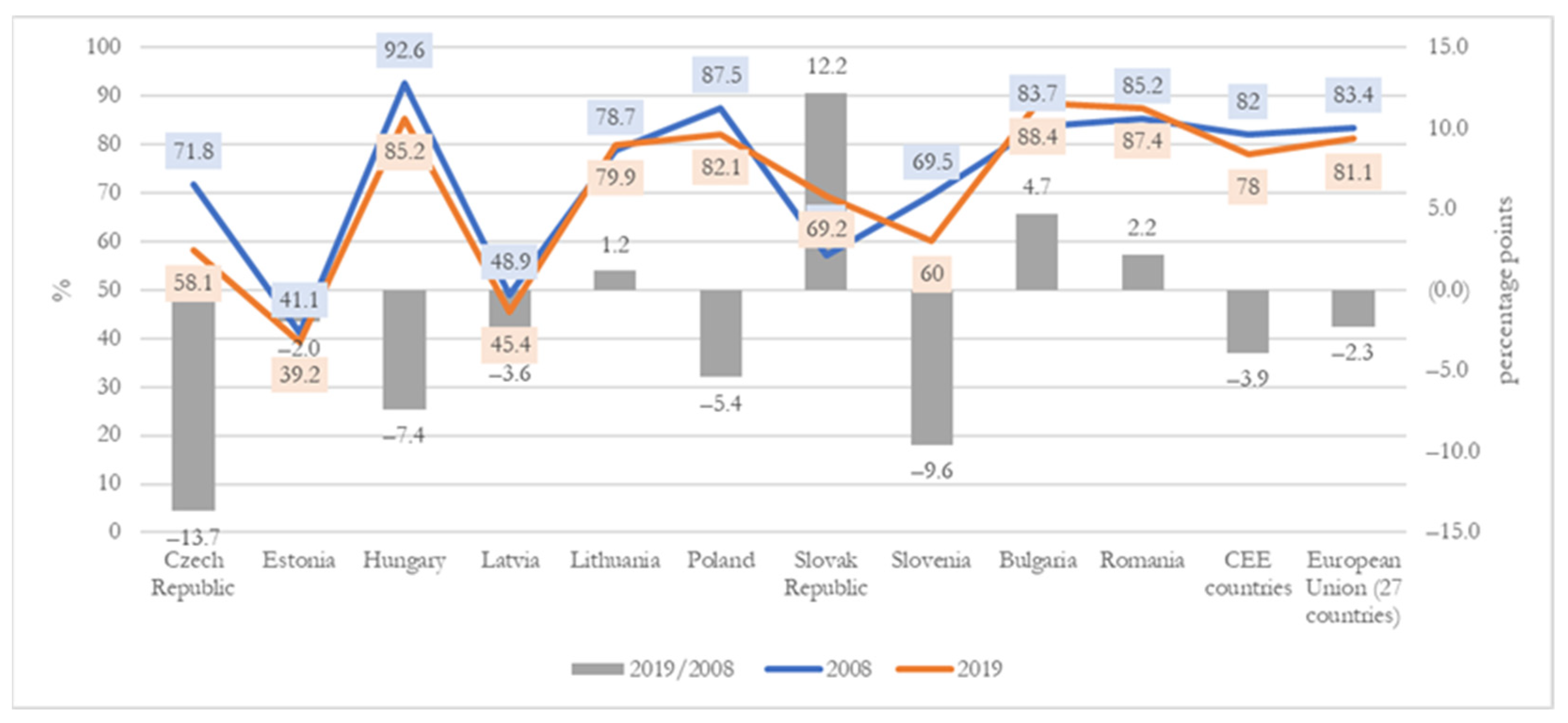
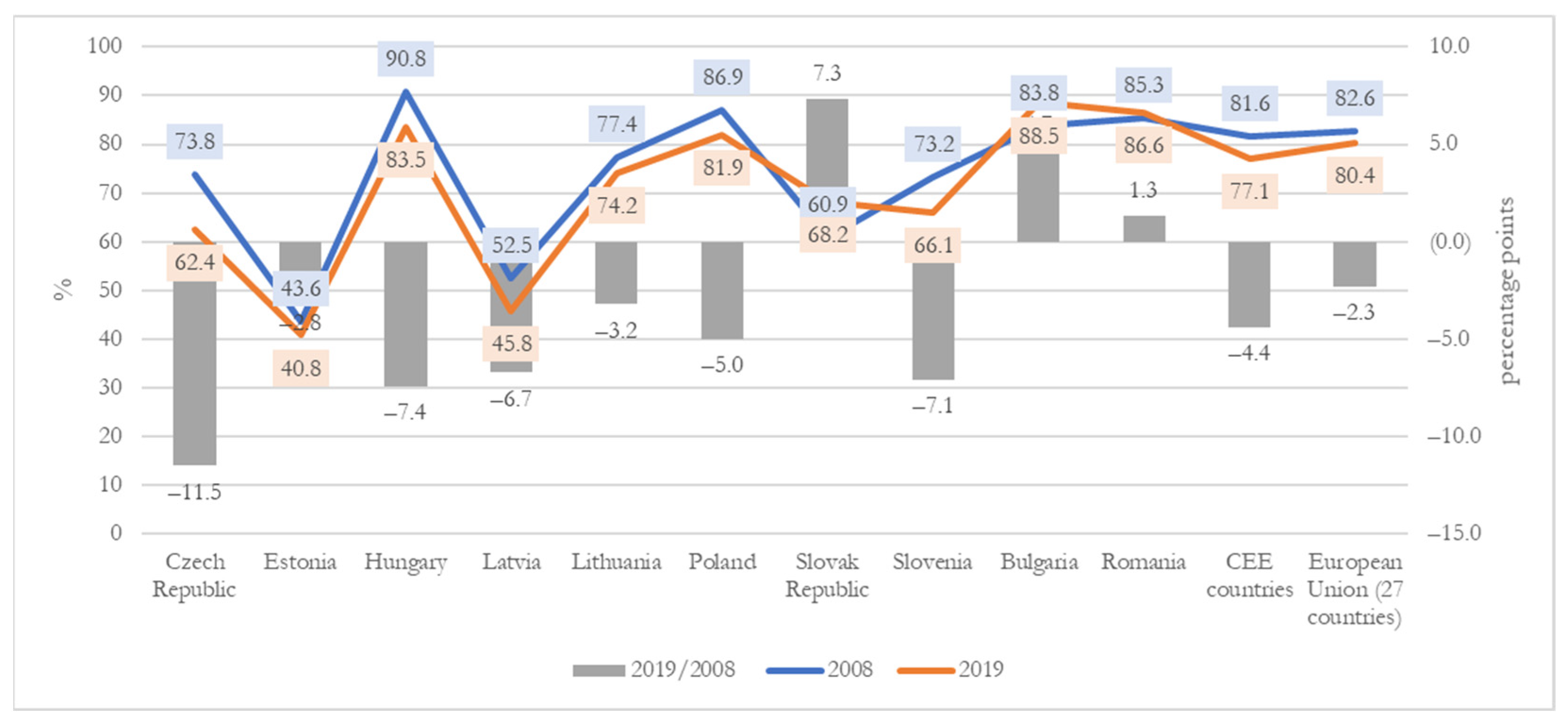
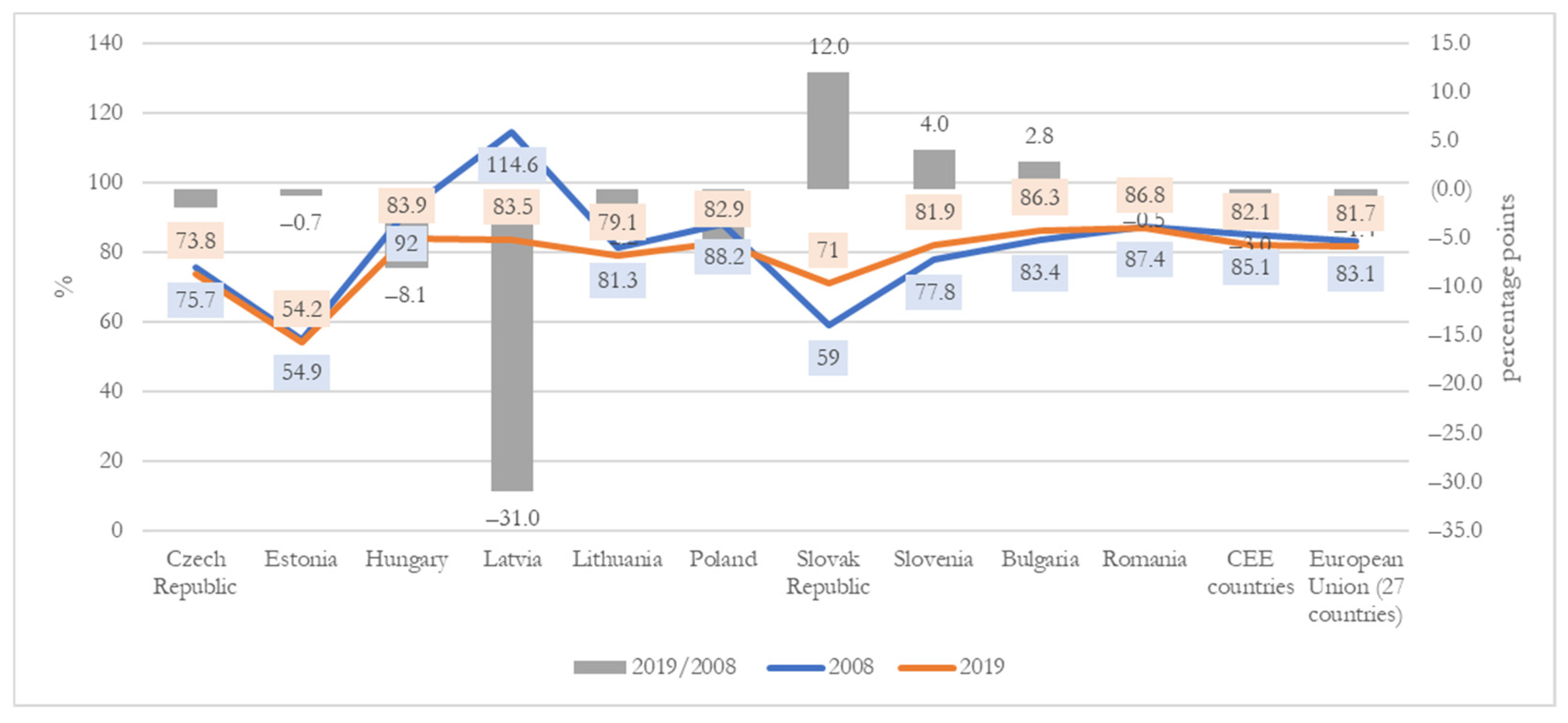
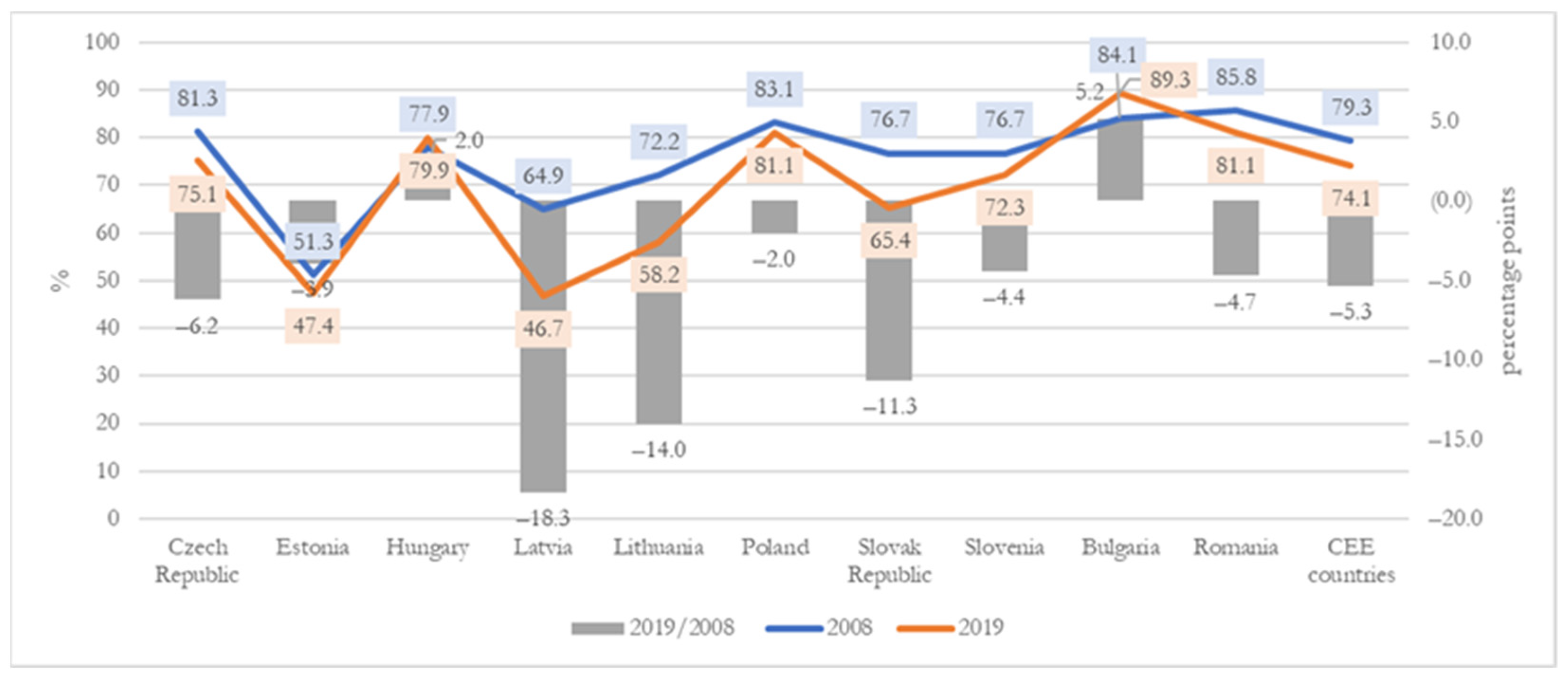
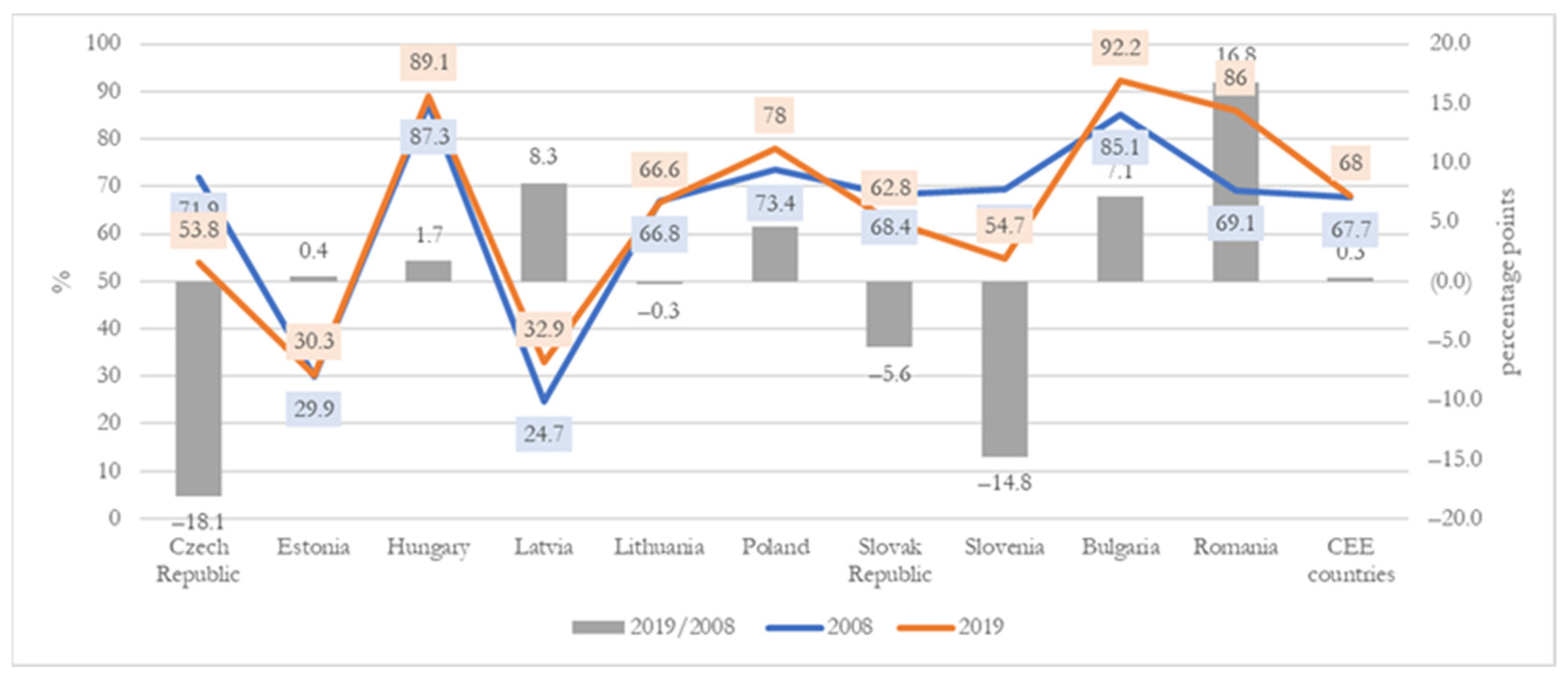
| Countries | Location Quotient * | Number of Persons Employed (Number) | ||
|---|---|---|---|---|
| 2019 | 2019 | 2019/2008 (%) | 2019 (%) | |
| Bulgaria | 2.75 | 773,528.3 | 79.8 | 11.28 |
| Czech Rep. | 0.84 | 387,509.6 | 88.4 | 5.65 |
| Estonia | 1.06 | 61,756.4 | 85.7 | 0.90 |
| Hungary | 0.95 | 372,592.8 | 100.6 | 5.43 |
| Latvia | 1.52 | 120,455.1 | 79.3 | 1.76 |
| Lithuania | 1.55 | 186,023.5 | 82.2 | 2.71 |
| Poland | 1.65 | 2,369,058.9 | 78.1 | 34.55 |
| Romania | 3.05 | 2,308,292.4 | 67.7 | 33.66 |
| Slovakia | 0.72 | 161,568.0 | 94.2 | 2.36 |
| Slovenia | 1.36 | 116,555.3 | 83.6 | 1.70 |
| CEE countries | 6,857,340.3 (39.35% of EU-27) | 76.4 | 100.0 | |
| Countries | Turnover (EUR Million) | Value Added at Factor Cost (EUR Million) | Productivity (Turnover/Persons Employed, EUR Thousand/Person) | |||||
|---|---|---|---|---|---|---|---|---|
| 2019 | 2019/2008 (%) | 2019% | 2019 | 2019/2008 (%) | 2019% | 2019 | 2019/2008 (%) | |
| Bulgaria | 14,737.5 | 116.0 | 4.55 | 4270.4 | 118.3 | 4.72 | 4270.4 | 118.3 |
| Czech Rep. | 38,275.8 | 114.8 | 11.83 | 10,817.4 | 127.1 | 11.96 | 10,817.4 | 127.1 |
| Estonia | 7585.4 | 167.3 | 2.34 | 1934.7 | 150.6 | 2.14 | 1934.7 | 150.6 |
| Hungary | 31,940.9 | 120.7 | 9.87 | 9831.7 | 135.5 | 10.87 | 9831.7 | 135.5 |
| Latvia | 8036.8 | 142.0 | 2.48 | 2505.3 | 153.4 | 2.77 | 2505.3 | 153.4 |
| Lithuania | 12,460.6 | 152.4 | 3.85 | 3640.1 | 168.6 | 4.02 | 3640.1 | 168.6 |
| Poland | 146,878.0 | 143.6 | 45.38 | 36,649.4 | 139.3 | 40.51 | 36,649.4 | 139.3 |
| Romania | 42,804.9 | 108.9 | 13.23 | 14,650.0 | 105.6 | 16.19 | 14,650.0 | 105.6 |
| Slovakia | 12,832.2 | 115.4 | 3.97 | 3469.4 | 114.4 | 3.84 | 3469.4 | 114.4 |
| Slovenia | 8077.5 | 108.6 | 2.50 | 2696.3 | 119.4 | 2.98 | 2696.3 | 119.4 |
| CEE countries | 323,629.4 (13.8% of EU 27) | 128.9 | 100.0 | 90,464.8 (13.76% of EU 27) | 129.4 | 100.0 | 90,464.8 (13.76% of EU 27) | 129.4 |
| Countries | Number of Persons Employed (Thousand Persons) | Turnover (EUR Billion) | Value Added at Factor Cost (EUR Billion) | ||||||
|---|---|---|---|---|---|---|---|---|---|
| 2019 | 2019/2008 (%) | 2019% | 2019 | 2019/2008 (%) | 2019% | 2019 | 2019/2008 (%) | 2019% | |
| Bulgaria | 571.8 | 79.8 | 12.98 | 4.3 | 87.5 | 5.44 | 10.6 | 120.5 | 32.73 |
| Czech Rep. | 137.9 | 98 | 3.13 | 9 | 140.8 | 11.42 | 8.2 | 97.6 | 25.46 |
| Estonia | 14.1 | 78.9 | 0.32 | 1 | 149.5 | 1.27 | 4.6 | 130 | 14.22 |
| Hungary | 164.5 | 100.2 | 3.73 | 10.2 | 113.7 | 12.87 | 3.5 | 150.1 | 10.86 |
| Latvia | 45.4 | 70.5 | 1.03 | 1.7 | 154.3 | 2.21 | 1.7 | 85.8 | 5.37 |
| Lithuania | 75.8 | 77.9 | 1.72 | 3.2 | 130 | 4.07 | 1.2 | 101 | 3.81 |
| Poland | 1418.70 | 66.7 | 32.2 | 28.9 | 118.3 | 36.52 | 1 | 105.4 | 2.96 |
| Romania | 1866.70 | 65.6 | 42.36 | 16.4 | 85.7 | 20.75 | 0.6 | 141.6 | 1.91 |
| Slovakia | 46.3 | 83.2 | 1.05 | 2.9 | 102.5 | 3.67 | 0.6 | 156.5 | 1.79 |
| Slovenia | 65 | 84.6 | 1.48 | 1.4 | 112.5 | 1.78 | 0.3 | 128.2 | 0.89 |
| CEE countries | 4406.2 (49.90% of EU-27) | 69.9 | 100 | 79 (18.08% of EU-27) | 109.5 | 100 | 32.3 (16.74% of EU-27) | 114.4 | 100 |
| Countries | Number of Persons Employed (Thousand Persons) | Turnover (EUR Billion) | Value Added at Factor Cost (EUR Billion) | ||||||
|---|---|---|---|---|---|---|---|---|---|
| 2019 | 2019/2008 (%) | 2019% | 2019 | 2019/2008 (%) | 2019% | 2019 | 2019/2008 (%) | 2019% | |
| Bulgaria | 81,172.0 | 90.8 | 8.07 | 5484.0 | 156.7 | 4.69 | 1034.2 | 181.4 | 4.75 |
| Czech Rep. | 99,587.0 | 92.5 | 9.90 | 12,442.8 | 100.4 | 10.65 | 2435.9 | 121.4 | 11.19 |
| Estonia | 13,262.0 | 93.7 | 1.32 | 1855.9 | 149.0 | 1.59 | 369.9 | 154.2 | 1.70 |
| Hungary | 95,262.0 | 99.7 | 9.47 | 11,080.6 | 119.7 | 9.48 | 2187.6 | 143.3 | 10.05 |
| Latvia | 20,592.0 | 74.9 | 2.05 | 1701.9 | 112.5 | 1.46 | 390.2 | 114.0 | 1.79 |
| Lithuania | 38,174.0 | 87.1 | 3.80 | 4029.2 | 142.9 | 3.45 | 805.8 | 181.3 | 3.70 |
| Poland | 439,082.0 | 108.5 | 43.67 | 63,090.0 | 155.9 | 54.00 | 11,445.2 | 150.5 | 52.56 |
| Romania | 162,190.0 | 92.6 | 16.13 | 10,827.9 | 129.4 | 9.27 | 1795.3 | 104.9 | 8.24 |
| Slovakia | 38,847.0 | 115.2 | 3.86 | 4077.9 | 123.2 | 3.49 | 766.9 | 156.1 | 3.52 |
| Slovenia | 17,315.0 | 108.4 | 1.72 | 2244.5 | 116.4 | 1.92 | 545.3 | 146.0 | 2.50 |
| CEE countries | 1,005,483 (24.07% of EU 27) | 99.8 | 100.0 | 116,834.7 (12.08% of EU 27) | 137.8 | 100.0 | 21,776.3 (11.45% of EU 27) | 142.2 | 100.0 |
| Countries | Agriculture-Based Bioeconomy Sector (EUR Thousand/Person) | Food-Based Bioeconomy Sector (EUR Thousand/Person) | ||
|---|---|---|---|---|
| 2019 | 2019/2008 (%) | 2019 | 2019/2008 (%) | |
| Bulgaria | 7.52 | 109.8 | 67.56 | 172.5 |
| Czech Rep. | 65.42 | 143.7 | 124.94 | 108.5 |
| Estonia | 71.17 | 189.5 | 139.94 | 159.1 |
| Hungary | 61.82 | 113.5 | 116.32 | 120.0 |
| Latvia | 38.46 | 219 | 82.65 | 150.1 |
| Lithuania | 42.47 | 166.9 | 105.55 | 164.1 |
| Poland | 20.34 | 177.5 | 143.69 | 143.7 |
| Romania | 8.78 | 130.6 | 66.76 | 139.7 |
| Slovakia | 62.79 | 123.2 | 104.97 | 106.9 |
| Slovenia | 21.6 | 132.9 | 129.63 | 107.4 |
| CEE countries | 17.94 | 156.8 | 116.20 | 138.0 |
| Countries | Total Biomass (Tons, Millions) | Biomass for Food and Feed (Tons, Millions) | ||||||
|---|---|---|---|---|---|---|---|---|
| 2008 | 2019 | 2019 (%) | 2019/2008 (%) | 2008 | 2019 | 2019 (%) | 2019/2008 (%) | |
| Bulgaria | 22.20 | 30.84 | 7.31 | 138.9 | 18.6 | 27.3 | 8.28 | 146.7 |
| Czech Rep. | 33.67 | 42.04 | 9.96 | 124.9 | 24.2 | 24.4 | 7.42 | 101.0 |
| Estonia | 6.99 | 11.77 | 2.79 | 168.3 | 2.9 | 4.6 | 1.40 | 160.3 |
| Hungary * | 47.14 | 47.06 | 11.15 | 99.8 | 43.6 | 40.1 | 12.17 | 91.9 |
| Latvia | 10.56 | 14.77 | 3.50 | 139.8 | 5.2 | 6.7 | 2.03 | 129.7 |
| Lithuania | 17.39 | 21.69 | 5.14 | 124.7 | 13.7 | 17.3 | 5.26 | 126.6 |
| Poland | 165.17 | 142.00 | 33.64 | 86.0 | 144.5 | 116.5 | 35.38 | 80.7 |
| Romania | 63.27 | 85.42 | 20.23 | 135.0 | 53.9 | 74.7 | 22.67 | 138.5 |
| Slovakia | 22.26 | 19.85 | 4.70 | 89.2 | 12.7 | 13.7 | 4.17 | 108.2 |
| Slovenia | 5.56 | 6.72 | 1.59 | 120.9 | 3.9 | 4.0 | 1.22 | 104.2 |
| CEE countries | 394.21 | 422.15 | 100.0 | 107.1 | 323.11 | 329.42 | 100.0 | 102.0 |
| EU (27 countries) * | 1532.08 | 1521.06 | 99.3 | 1277.1 | 1233.6 | 96.6 | ||
| CEE (%) | 25.73 | 27.75 | - | 25.30 | 26.70 | - | ||
| Countries | Total Biomass (Tons, Millions) | Biomass for Food and Feed (Tons, Millions) | ||||||
|---|---|---|---|---|---|---|---|---|
| 2008 | 2019 | 2019 (%) | 2019/2008 (%) | 2008 | 2019 | 2019 (%) | 2019/2008 (%) | |
| Bulgaria | 25.20 | 35.36 | 6.67 | 140.3 | 21.11 | 31.30 | 7.65 | 148.3 |
| Czech Rep. | 42.79 | 56.02 | 10.56 | 130.9 | 31.60 | 34.93 | 8.54 | 110.5 |
| Estonia | 9.21 | 14.75 | 2.78 | 160.2 | 4.01 | 6.02 | 1.47 | 150.0 |
| Hungary * | 53.55 | 57.14 | 10.78 | 106.7 | 48.64 | 47.69 | 11.66 | 98.1 |
| Latvia | 13.56 | 21.95 | 4.14 | 161.9 | 7.11 | 10.05 | 2.46 | 141.4 |
| Lithuania | 21.69 | 29.47 | 5.56 | 135.9 | 16.79 | 21.86 | 5.34 | 130.2 |
| Poland | 189.77 | 176.85 | 33.35 | 93.2 | 164.94 | 144.80 | 35.40 | 87.8 |
| Romania | 70.58 | 97.97 | 18.48 | 138.8 | 60.20 | 84.86 | 20.75 | 141.0 |
| Slovakia | 27.67 | 27.42 | 5.17 | 99.1 | 16.85 | 18.69 | 4.57 | 110.9 |
| Slovenia | 11.31 | 13.31 | 2.51 | 117.7 | 8.27 | 8.80 | 2.15 | 106.3 |
| CEE countries | 465.33 | 530.23 | 100.0 | 113.9 | 379.52 | 408.99 | 100.0 | 107.8 |
| EU (27 countries) * | 2110.38 | 2204.39 | 104.5 | 1743.58 | 1771.53 | 101.6 | ||
| CEE (%) | 22.05 | 24.05 | - | 21.77 | 23.09 | - | ||
| Countries | Total Biomass (Tons, Millions) | Biomass for Food and Feed (Tons, Millions) | ||||||
|---|---|---|---|---|---|---|---|---|
| 2008 | 2019 | 2019 (%) | 2019/2008 (%) | 2008 | 2019 | 2019 (%) | 2019/2008 (%) | |
| Bulgaria | 20.04 | 21.88 | 6.21 | 109.2 | 16.72 | 18.87 | 6.52 | 112.9 |
| Czech Rep. | 22.14 | 23.93 | 6.79 | 108.1 | 16.75 | 17.65 | 6.10 | 105.4 |
| Estonia | 5.03 | 6.48 | 1.84 | 128.9 | 2.76 | 3.51 | 1.21 | 127.2 |
| Hungary * | 40.07 | 38.57 | 10.94 | 96.3 | 36.87 | 32.38 | 11.19 | 87.8 |
| Latvia | 4.19 | 5.59 | 1.58 | 133.2 | 4.80 | 4.67 | 1.61 | 97.2 |
| Lithuania | 15.82 | 17.85 | 5.06 | 112.8 | 12.87 | 14.12 | 4.88 | 109.8 |
| Poland | 172.92 | 140.38 | 39.83 | 81.2 | 152.57 | 116.37 | 40.22 | 76.3 |
| Romania | 62.61 | 74.17 | 21.04 | 118.5 | 54.69 | 64.40 | 22.26 | 117.8 |
| Slovak Rep. | 22.08 | 18.04 | 5.12 | 81.7 | 13.02 | 12.80 | 4.42 | 98.3 |
| Slovenia | 5.02 | 5.59 | 1.59 | 111.4 | 3.91 | 4.58 | 1.58 | 117.1 |
| CEE countries | 369.92 | 352.47 | 100.00 | 95.3 | 314.96 | 289.35 | 100.00 | 91.9 |
| EU (27 countries) * | 1565.61 | 1510.28 | 96.5 | 1301 | 1233.80 | 94.8 | ||
| CEE (%) | 23.63 | 23.34 | - | 24.21 | 23.45 | - | ||
| Countries | Total Biomass (Tons, Millions) | Biomass for Food and Feed (Tons, Millions) | ||||||
|---|---|---|---|---|---|---|---|---|
| 2008 | 2019 | 2019 (%) | 2019/2008 (%) | 2008 | 2019 | 2019 (%) | 2019/2008 (%) | |
| Bulgaria | 3.00 | 4.52 | 4.18 | 150.7 | 2.52 | 4.03 | 5.04 | 160.0 |
| Czech Republic | 9.13 | 13.98 | 12.93 | 153.2 | 7.42 | 10.50 | 13.12 | 141.4 |
| Estonia | 2.22 | 2.98 | 2.76 | 134.5 | 1.14 | 1.41 | 1.76 | 124.1 |
| Hungary * | 6.41 | 10.08 | 9.33 | 157.3 | 4.99 | 8.06 | 10.07 | 161.4 |
| Latvia | 2.99 | 7.18 | 6.64 | 239.9 | 1.94 | 3.35 | 4.19 | 172.5 |
| Lithuania | 4.29 | 7.78 | 7.20 | 181.3 | 3.10 | 4.53 | 5.66 | 146.0 |
| Poland | 24.61 | 34.85 | 32.24 | 141.6 | 20.45 | 28.27 | 35.31 | 138.2 |
| Romania | 7.31 | 12.55 | 11.61 | 171.6 | 6.28 | 10.18 | 12.72 | 162.2 |
| Slovakia | 5.42 | 7.58 | 7.01 | 139.9 | 4.15 | 4.95 | 6.19 | 119.3 |
| Slovenia | 5.75 | 6.59 | 6.09 | 114.6 | 4.41 | 4.76 | 5.95 | 108.1 |
| CEE countries | 71.11 | 108.08 | 100.00 | 152.0 | 56.41 | 80.04 | 100.00 | 141.9 |
| Countries | Total Biomass (Tons, Millions) | Biomass for Food and Feed (Tons, Millions) | ||||||
|---|---|---|---|---|---|---|---|---|
| 2008 | 2019 | 2019 (%) | 2019/2008 (%) | 2008 | 2019 | 2019 (%) | 2019/2008 (%) | |
| Bulgaria | 5.15 | 13.48 | 7.58 | 261.6 | 4.39 | 12.43 | 10.28 | 283.3 |
| Czech Republic | 20.66 | 32.09 | 18.05 | 155.3 | 14.85 | 17.28 | 14.29 | 116.3 |
| Estonia | 4.18 | 8.27 | 4.65 | 197.8 | 1.25 | 2.51 | 2.08 | 200.5 |
| Hungary * | 13.48 | 18.57 | 10.45 | 137.8 | 11.77 | 16.54 | 13.68 | 140.5 |
| Latvia | 9.36 | 16.36 | 9.20 | 174.7 | 2.31 | 5.39 | 4.46 | 233.3 |
| Lithuania | 5.86 | 11.62 | 6.54 | 198.2 | 3.92 | 7.74 | 6.40 | 197.4 |
| Poland | 16.86 | 36.47 | 20.52 | 216.4 | 12.37 | 28.43 | 23.52 | 229.8 |
| Romania | 7.98 | 23.80 | 13.39 | 298.4 | 5.51 | 20.46 | 16.93 | 371.2 |
| Slovakia | 5.59 | 9.38 | 5.28 | 167.8 | 3.82 | 5.89 | 4.87 | 154.0 |
| Slovenia | 6.29 | 7.72 | 4.34 | 122.7 | 4.37 | 4.22 | 3.49 | 96.6 |
| CEE countries | 95.41 | 177.77 | 100.00 | 186.3 | 64.56 | 120.87 | 100.00 | 187.2 |
| Countries | Domestic Extraction Used | Import | Domestic Material Consumption | Export | Share of (Export–Import) in Domestic Extraction Used (%) | Share of Domestic Material Consumption in Domestic Extraction Used (%) |
|---|---|---|---|---|---|---|
| Total Biomass (tons, millions) | ||||||
| Bulgaria | 30.84 | 4.52 | 21.88 | 13.48 | 29.1 | 70.9 |
| Czech Rep. | 42.04 | 13.98 | 23.93 | 32.09 | 43.1 | 56.9 |
| Estonia | 11.77 | 2.98 | 6.48 | 8.27 | 44.9 | 55.1 |
| Hungary * | 47.06 | 10.08 | 38.57 | 18.57 | 18.0 | 82.0 |
| Latvia | 14.77 | 7.18 | 5.59 | 16.36 | 62.2 | 37.8 |
| Lithuania | 21.69 | 7.78 | 17.85 | 11.62 | 17.7 | 82.3 |
| Poland | 142 | 34.85 | 140.38 | 36.47 | 1.1 | 98.9 |
| Romania | 85.42 | 12.55 | 74.17 | 23.8 | 13.2 | 86.8 |
| Slovakia | 19.85 | 7.58 | 18.04 | 9.38 | 9.1 | 90.9 |
| Slovenia | 6.72 | 6.59 | 5.59 | 7.72 | 16.8 | 83.2 |
| CEE countries | 422.15 | 108.08 | 352.47 | 177.77 | 16.5 | 83.5 |
| Biomass for food and feed (tons, millions) | ||||||
| Bulgaria | 27.3 | 4.0 | 18.9 | 12.4 | 30.8 | 69.1 |
| Czech Rep. | 24.4 | 10.5 | 17.7 | 17.3 | 27.8 | 72.3 |
| Estonia | 4.6 | 1.4 | 3.5 | 2.5 | 23.9 | 76.3 |
| Hungary | 40.1 | 8.1 | 32.4 | 16.5 | 21.1 | 80.7 |
| Latvia | 6.7 | 3.4 | 4.7 | 5.4 | 30.4 | 69.7 |
| Lithuania | 17.3 | 4.5 | 14.1 | 7.7 | 18.6 | 81.6 |
| Poland | 116.5 | 28.3 | 116.4 | 28.4 | 0.1 | 99.9 |
| Romania | 74.7 | 10.2 | 64.4 | 20.5 | 13.8 | 86.2 |
| Slovakia | 13.7 | 5.0 | 12.8 | 5.9 | 6.9 | 93.4 |
| Slovenia | 4.0 | 4.8 | 4.6 | 4.2 | −13.5 | 114.5 |
| CEE countries | 329.4 | 80.0 | 289.4 | 120.9 | 12.4 | 87.8 |
Publisher’s Note: MDPI stays neutral with regard to jurisdictional claims in published maps and institutional affiliations. |
© 2022 by the authors. Licensee MDPI, Basel, Switzerland. This article is an open access article distributed under the terms and conditions of the Creative Commons Attribution (CC BY) license (https://creativecommons.org/licenses/by/4.0/).
Share and Cite
Vlad, I.M.; Toma, E. The Assessment of the Bioeconomy and Biomass Sectors in Central and Eastern European Countries. Agronomy 2022, 12, 880. https://doi.org/10.3390/agronomy12040880
Vlad IM, Toma E. The Assessment of the Bioeconomy and Biomass Sectors in Central and Eastern European Countries. Agronomy. 2022; 12(4):880. https://doi.org/10.3390/agronomy12040880
Chicago/Turabian StyleVlad, Ionela Mițuko, and Elena Toma. 2022. "The Assessment of the Bioeconomy and Biomass Sectors in Central and Eastern European Countries" Agronomy 12, no. 4: 880. https://doi.org/10.3390/agronomy12040880
APA StyleVlad, I. M., & Toma, E. (2022). The Assessment of the Bioeconomy and Biomass Sectors in Central and Eastern European Countries. Agronomy, 12(4), 880. https://doi.org/10.3390/agronomy12040880






